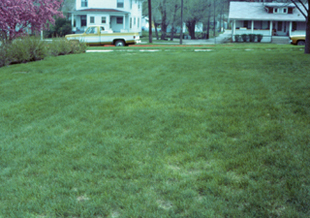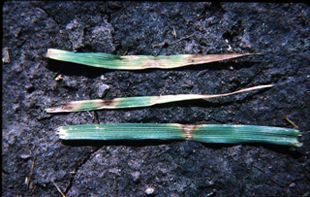G1915
Leaf Spot and Melting Out of Turf
Leaf spot and melting out are two different turf diseases with similar symptoms. This NebGuide discusses how to identify and manage these diseases.
Loren J. Giesler, Extension Plant Pathologist
- Introduction
- Cause, Hosts, and Occurrence
- Key Symptoms
- Cultural/Maintenance Practices
- Fungicide Program
Introduction
Leaf spot and melting out are two different turf diseases that have similar symptoms. They both primarily affect Kentucky bluegrass, perennial ryegrass, and tall fescue, and occur in the cooler spring and late summer months. Creeping bentgrass can also be affected but not as often. The disease is most active on stressed or poorly managed turf (Figures 1 and 2). The best way to control these diseases is to manage turf properly and to use cultural practices that help prevent their establishment. Fungicides may be used early in the season as a preventive measure. Once the disease has reached the melting out stage, turf may continue to decline after fungicide application but spread will be limited. The following information describes the diseases and how to identify and manage them.
 |
 |
|
| Figure 1. Turf will appear off-color from a distance and thinning will result from leaf spot and/or melting out. | Figure 2. Individual leaf blades with purple/brown lesions from leaf spot (Photo courtesy of B. Bockus, Bugwood.org) |
Cause, Hosts, and Occurrence
Causes: Bipolaris and Drechslera spp. (formerly known as Helminthosporium spp.)
Primary Hosts: Kentucky bluegrass, perennial ryegrass, and tall fescue
Occurrence: April-June; September-October
Key Symptoms
- Round to oval leaf spots with buff-colored centers surrounded by a dark margin.
- Yellowing or off-color diffuse pattern of affected turf.
- Symptoms can resemble gray leaf spot on perennial ryegrass.
- Melting out symptoms will appear as a reddish brown rotting of the leaf sheaths and crowns.
- Symptoms on bentgrass greens range from a smoky-gray to reddish cast to yellowing, blighting, and thinning of the turf.
Cultural/Maintenance Practices
- Use resistant cultivars when available.
- Provide sufficient nitrogen to maintain moderate growth rate through the season but avoid excess nitrogen, particularly in early spring. Slow release products are preferred.
- Irrigate to maintain plant vigor and avoid drought stress.
- Irrigate in the early morning to minimize leaf wetness.
- Raise mowing height during July and August.
- Aerify in May and/or September to control thatch buildup.
- Collect clippings when disease is active.
Fungicide Program
On professionally managed turf with a history of leaf spot, a preventive fungicide program from mid-April through early June may be effective. A curative application can be used but should be applied at the early stages of disease development. Once the disease has developed to the melting out stage, a curative application will limit spread of disease but not cure infected plants. Fungicide use on home lawns is rarely recommended for this disease.
Fungicides for leaf spot and melting out are presented in Table I. Product examples are provided for each active ingredient, but not all products are listed. Homeowner and commercial product labels will have a section that provides a list of active ingredients. While the active ingredient may be in combination with others, users should look for a specific active ingredient with or without other chemistry modes of action.
Fungicides listed represent the best information available. Read and follow all product label directions for mixing and application.
| Table I. Fungicides for Control of Leaf Spot and Melting Out1 | ||||
| Fungicide | Fungicide Class | Interval (days) |
Efficacy2 |
Product Names |
| Azoxystrobin | Strobilurin | 14-21 |
3+ |
Heritage® |
| Captan | Phthalimide | 7-10 |
L |
Captan |
| Chlorothalonil | Chloronitrile | 7-10 |
2+ |
Daconil Ultrex®3 |
| Copper hydroxide + mancozeb | Inorganic + dithiocarbamate | 7-14 |
L |
Junction™ |
| Fludioxonil | Phenylpyrrole | 14-21 |
3+ |
Medallion® |
| Fluoxastrobin | Strobilurin | 14-21 |
L |
Disarm® |
| Hydrogen | Dioxide | 7 |
L |
ZeroTol® |
| Iprodione | Dicarboximide | 14-28 |
4 |
Chipco® 26GT3 |
| Mancozeb | Dithiocarbamate | 7-14 |
3+ |
Fore®3 |
| Mineral Oil | Not Classified | 7-21 |
L |
Civitas™ |
| Myclobutanil | DMI4 | 14 |
1 |
Eagle® |
| PCNB | AH4 | 21-28 |
2 |
Cleary’s PCNB3 |
| Polyoxin D | Polyoxin | 7-14 |
L |
Endorse® |
| Propiconazole | DMI | 14 |
2 |
Banner® Maxx®3 |
| Pyraclostrobin | Strobilurin | 14-28 |
3 |
Insignia® |
| Thiophanate-Methyl | MBC4 | 7-14 |
2 |
Cleary’s 3336®3 |
| Trifloxystrobin | Strobilurin | 14-28 |
2+ |
Compass® |
| Triticonazole | DMI | 14-28 |
L |
Trinity® |
| Vinclozolin | Dicarboximide | 14-28 |
3.5 |
Curalan®3 |
| 1Fungicide active ingredients, class, and efficacy ratings for products labeled for the control of leaf spot and melting out. Table adapted from P. Vincelli and D.W. Williams, Chemical Control of Turfgrass Diseases 2011, University of Kentucky Cooperative Extension Service.
2Rating system: 4 = consistently good control; 3 = good to excellent control; 2 = fair to good control; 1 = control is inconsistent but performs well in some instances; L = limited published data on effectiveness; + = intermediate between two efficacy categories. 3Other products with the same active ingredient may be available. 4DMI fungicides are demethylation inhibitors and are otherwise known as Triazole fungicides. AH = Aromatic Hydrocarbons, MBC = Methyl Benzimidazole Carbamate. |
||||
This publication has been peer reviewed.
Disclaimer Reference to commercial products or trade names is made with the understanding that no discrimination is intended of those not mentioned and no endorsement by University of Nebraska–Lincoln Extension is implied for those mentioned. |
Visit the University of Nebraska–Lincoln Extension Publications website for more publications.
Index: Plant Diseases
Turf
Issued July 2011